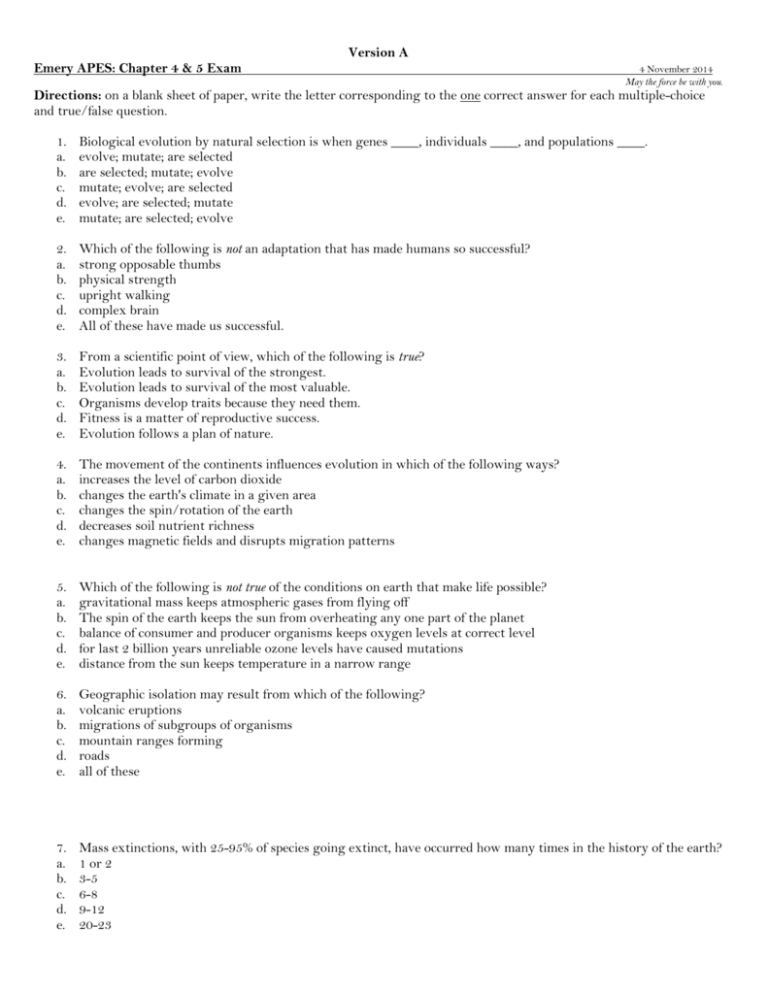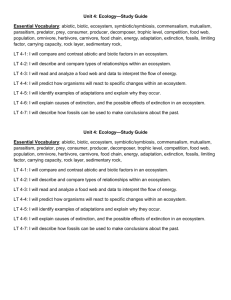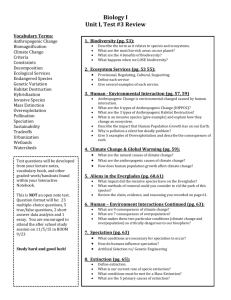Version A Emery APES: Chapter 4 & 5 Exam 4 November 2014 May
advertisement

Version A Emery APES: Chapter 4 & 5 Exam 4 November 2014 May the force be with you. Directions: on a blank sheet of paper, write the letter corresponding to the one correct answer for each multiple-choice and true/false question. 1. a. b. c. d. e. Biological evolution by natural selection is when genes ____, individuals ____, and populations ____. evolve; mutate; are selected are selected; mutate; evolve mutate; evolve; are selected evolve; are selected; mutate mutate; are selected; evolve 2. a. b. c. d. e. Which of the following is not an adaptation that has made humans so successful? strong opposable thumbs physical strength upright walking complex brain All of these have made us successful. 3. a. b. c. d. e. From a scientific point of view, which of the following is true? Evolution leads to survival of the strongest. Evolution leads to survival of the most valuable. Organisms develop traits because they need them. Fitness is a matter of reproductive success. Evolution follows a plan of nature. 4. a. b. c. d. e. The movement of the continents influences evolution in which of the following ways? increases the level of carbon dioxide changes the earth's climate in a given area changes the spin/rotation of the earth decreases soil nutrient richness changes magnetic fields and disrupts migration patterns 5. a. b. c. d. e. Which of the following is not true of the conditions on earth that make life possible? gravitational mass keeps atmospheric gases from flying off The spin of the earth keeps the sun from overheating any one part of the planet balance of consumer and producer organisms keeps oxygen levels at correct level for last 2 billion years unreliable ozone levels have caused mutations distance from the sun keeps temperature in a narrow range 6. a. b. c. d. e. Geographic isolation may result from which of the following? volcanic eruptions migrations of subgroups of organisms mountain ranges forming roads all of these 7. a. b. c. d. e. Mass extinctions, with 25-95% of species going extinct, have occurred how many times in the history of the earth? 1 or 2 3-5 6-8 9-12 20-23 Version A 8. a. b. c. d. e. Biodiversity includes all of the following components except functional diversity genetic diversity intellectual diversity ecological diversity species diversity 9. a. b. c. d. e. The diversity that enables life on earth to adapt and survive environmental changes is called functional diversity genetic diversity intellectual diversity ecological diversity species diversity 10. The variety of processes, including matter cycling and energy flow within ecosystems, which result from species interacting with one another in food webs is called a. functional diversity b. genetic diversity c. intellectual diversity d. ecosystem diversity e. species diversity 11. a. b. c. d. e. A change in the genetic characteristics of a population from one generation to another is called emigration mutation natural selection evolution genetic drift 12. a. b. c. d. e. Mutations are not caused by which of the following? ultraviolet light a physical accident happening to a parent radioactivity certain chemicals X rays 13. a. b. c. d. e. 14. For natural selection to occur, an adaptive trait Must also be a physical trait Must also be a physiological trait Must also be a psychological trait Must also be a heritable trait Must not be a physical trait A species in an ecosystem that plays a central role in the health of that ecosystem, and whose removal may cause the collapse of the ecosystem, is called a(n) foundation species indicator species native species keystone species specialist species a. b. c. d. e. 15. A species in an ecosystem that shapes communities by creating and enhancing habitats in ways that benefit other species is called a. foundation species b. indicator species Version A c. native species d. keystone species e. specialist species 16. a. b. c. d. e. The primary reason why southern sea otter recovery is important is They are super cute They are a keystone species They encourage tourism It is unethical to cause their extinction They have luxurious, thick fur 17. a. b. c. d. e. Which of the following is the most common interaction between species? competition predation parasitism mutualism commensalism 18. Which of the following is said to occur when an interaction benefits one species but has little, if any, effect on the other? a. interspecific competition b. predation c. parasitism d. mutualism e. commensalism 19. Which of the following is said to occur when one organism feeds on another organism by living on or in the other organism? a. interspecific competition b. predation c. parasitism d. mutualism e. commensalism 20. a. b. c. d. e. 21. a. b. c. d. e. Biodiversity is believed to be the result of the interaction between geographic isolation and reproductive isolation speciation and extinction mass extinction and background extinction speciation and genetic engineering reproductive isolation and extinction Scientists have used genetic engineering to do all of the following, except develop modified crop plants develop human clones develop new drugs develop pest resistant plants and animals develop oil eating bacteria 22. a. b. c. d. e. The number of different species an ecosystem contains is its speciation species evenness species niche species richness habitat 23. Which of the following is true? a. The greater the species richness, the lower the productivity of the ecosystem. b. The greater the species richness, the lower the sustainability of the ecosystem. Version A c. The lower the species richness, the greater the productivity of the ecosystem. d. The lower the species richness, the greater the sustainability of the ecosystem. e. The greater the species richness, the greater the sustainability of the ecosystem. 24. a. b. c. d. e. a. b. c. d. e. An ecological niche includes all of the following except The species’ habitat How much water and sunlight the species needs The role the species plays/contributes within the ecosystem How much physical space the species needs The temperatures the species can tolerate 25. All of the following would be true of a specialist species, except live in one type of habitat use only one or a few types of food have a narrow range of tolerable climatic conditions less prone to extinction can tolerate only a few environmental conditions 26. a. b. c. d. e. Which of the following is another name for a nonnative species? native invasive keystone indicator foundation 27. a. b. c. d. e. Which of the following would not be considered predators? omnivores herbivores detritivores carnivores All of these are predators. 28. How would you describe the zone of salt tolerance for radish seeds? a. Radish seeds can germinate in any amount of salt b. Radishes are a keystone species c. Radishes are a specialist species d. Radishes have a very narrow zone of tolerance for salt e. Radishes have a relatively broad zone of tolerance for salt 29. If a species is endemic, it is most likely also: a. A keystone species b. Geographically isolated c. Reproductively isolated d. A generalist e. Tolerant of many environmental conditions 30. Which of the following is not a way that an invasive plant might spread in a new environment? a. By growing rapidly and producing a lot of seeds relative to native plants b. Seeds may “hitch a ride” on animals, tires, boats, airplanes that travel greater distances than the plant is capable of doing naturally c. Windstorms may carry seeds to the ocean d. Outcompeting native plants for resources (e.g., sunlight, water, soil minerals) e. Fending off predators more effectively than native plants Version A 31. An example of an organism in its zone of physiological stress could be: a. A female bobcat having only one kitten instead of the usual 2-4 b. Radish seeds unable to germinate in poor soil c. Nile perch (a type of fish) thriving with no predators d. Bengal tigers becoming classified as endangered e. Douglas fir seedlings being choked out (sunlight fully blocked) by adult Douglas fir trees 32. a. b. c. d. e. Which of the following is not a method predators use to capture prey? pursuit ambush camouflage biochemical warfare protective shells 33. When populations of two different species interact over long periods of time, changes in the gene pool of one species can lead to changes in the gene pool of the other. This is called a. competition b. coevolution c. coincidence d. commensalism e. predation 34. a. b. c. d. e. A group of interbreeding individuals of the same species in the same geographic region is called a(n) community population ecosystem biosphere biome 35. a. b. c. d. e. The relationship between clownfish and sea anemone is interspecific competition predation parasitism mutualism commensalism 36. a. b. c. d. e. Population size is determined by which of the following? emigration deaths immigration births all of these 37. Which of the following is the best reason why the bamboo lemur, like all lemurs, is facing extinction? a. It is a generalist species b. It is a specialist species c. It is endemic to a very narrow geographic region d. Its habitat has been experiencing substantial destruction and degradation in recent years e. They have been overexploited in the illegal pet trade 38. How did the invasive water hyacinth in Lake Victoria cause an increase in malaria and schistosomiasis? a. Water hyacinth causes these diseases when people eat infected plants b. Increased plant growth allowed more stagnant/standing water, which facilitates/helps these diseases spread c. Water hyacinth decreases water quality, which caused people to get sick from drinking the water d. Water hyacinth carries the mosquitoes and snails which cause these diseases Version A e. Water hyacinth prevented people from being able to bathe in the lake 39. Which of the following is not a reason why lionfish inhabiting the Gulf of Mexico, like many invasive species, have rapidly growing populations? a. The new environment has more available resources than the native environment b. The new environment has no/fewer predators c. The new environment is within the zone of tolerance for the invasive species d. They are typically able to outcompete native species for resources e. They are not exposed to the same diseases that were present in their native environment 40. Which of the following is not an effective means of controlling an invasive species population? a. Introducing additional invasive species to prey on the original invasive species b. Developing legislature that restricts the sale and transportation of the invasive species c. Encouraging hunting/harvesting of the invasive species (bounties, derbies, etc.) d. Requesting that people report any sightings to the Department of Fish and Wildlife e. Emphasis on redistributing the invasive species throughout the nonnative environment 41. Which of the following is an invasive species originally from Asia? a. Lionfish in the Gulf of Mexico b. Water hyacinth in Lake Victoria c. Formosa termites in New Orleans d. Two of these are correct e. None of the above True/False directions: Write “T” for true or “F” for false on your answer sheet for each statement below. 42. Biodiversity is a vital part of the natural capital that sustains all life. 43. Most of what we know about the earth's biological history comes from fossils. 44. A huge body of evidence supports the idea of biological evolution through natural selection. 45. Most mutations occur because of exposure to artificial external agents, such as radiation. 46. Individuals evolve. 47. Mutations are the source of natural selection. 48. Survival of the fittest refers to those individuals that produce the most offspring. 49. Species that are successful during one period of time because of selected adaptations may not be successful when environmental conditions change. 50. According to the theory of evolution, a giraffe evolved a long neck because it needs it to reach its food source. 51. Long-term climate changes determine where plant and animal species can survive. 52. Under rapidly changing environmental conditions, it is better to be a specialist species. 53. In communities and ecosystems the types and numbers of species change in response to changing environmental conditions. 54. Invasive species are only introduced to new areas due accidental or deliberate human activities. 55. There are always limits to population growth in nature. Version A 56. Species whose ecological niches overlap will be in competition for whatever the resource is in the overlap. 57. Predator and prey populations exert tremendous natural selection pressures on each other. 58. The most common interaction between species is commensalism. 59. Humans compete with many other species for space, food, and other resources. Congratulations! You’re finished. Please turn in your exam and answer sheet on lab station 7 (did you write Version A on it?). Then sit silently until all exams have been turned in.








